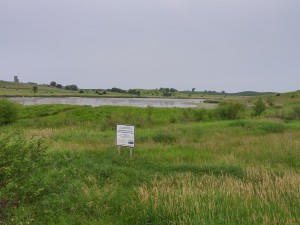
A conservation partnership utilizing a Farm Service Agency conservation program has allowed Iowa landowners to restore 72 shallow wetlands to improve surface water, increase wildlife habitat and provide recreational opportunities.
Conservation Program Restores Areas and Regains Environmental Benefits
Iowa is considered one of the most ecologically altered states in the nation. The Iowa Department of Natural Resources reports that about 10 percent of the state’s surface area was once comprised of wetlands, but that changed. Nearly 95 percent of the wetland basins were drained resulting in a loss of ecological benefits.
A conservation partnership among USDA, the Iowa Department of Agriculture and Land Stewardship and local Soil and Water Conservation Districts started to turn things around beginning in 2001 when they introduced the Conservation Reserve Enhancement Program (CREP). The partnership offered CREP, administered by USDA’s Farm Service Agency, to help landowners restore an initial 72 wetland areas. An additional 24 wetland areas are currently under development.
CREP targets high-priority conservation issues by forming a partnership between the federal government and state or tribal governments or other geopolitical bodies. Once a CREP agreement is formed, landowners can receive annual rental payments in exchange for removing environmentally sensitive land from production and implementing acceptable conservation practices. Today, 1.2 million acres on more than 47,000 farms are under CREP contracts across the country.
The Iowa CREP provides incentives to landowners who voluntarily restore shallow, semi-permanent wetlands in the heavily tile-drained regions of the state to improve surface water quality while providing valuable wildlife habitat and increased recreational opportunities.
“The goal of the program is to reduce nitrogen loads and the movement of other agricultural chemicals from croplands to streams and rivers by targeting wetland restorations to ‘sweet spots’ on the landscape that provide the greatest water quality benefits,” said Shawn Richmond, Iowa CREP coordinator, Iowa Department of Agriculture and Land Stewardship.
The wetland areas are expected to remove more than 100,000 tons of nitrogen from nearly 122,000 acres of cropland. In 2013, the number of restored wetlands reached an annual capacity of removing more than 500 tons, so there’s plenty of work ahead.
Overall, the 96 targeted restoration areas span more than 888 acres of wetlands and 3,100 acres of surrounding buffers planted to native prairie vegetation.
Even with the impressive results so far, teams in Iowa continue to explore and develop new technologies to optimize wetland performance by incorporating additional considerations for habitat, hydraulic efficiency and temporary flood storage benefits.
“The Iowa CREP continues to build nutrient-removal capacity with these wetlands and helps meet the goals of the Iowa Nutrient Reduction Strategy,” said Richmond. “We continue to seek out market-driven frameworks and other voluntary means of encouraging private investments in developing targeted water-quality wetlands.”
In addition to water quality benefits, CREP wetlands in Iowa also provide high-quality wildlife habitat and recreational opportunities.
“These buffers, in conjunction with the shallow wetland habitats, have proven to be a tremendous boom to a multitude of wildlife species commonly found in these areas,” said Richmond. “The areas have shown that targeting wetland restoration for water quality benefits does not come at the expense of mutual habitat and recreational benefits.”
CREP is part of USDA’s Conservation Reserve Program (CRP), one of the largest private lands conservation programs that is helping to reduce soil erosion, improve water and air quality and provide better wildlife habitat.
Since being established on December 23, 1985, CRP has helped prevent more than 8 billion tons of soil from eroding and protected more than 170,000 stream miles with riparian and grass buffers, more than 100,000 acres of bottomland hardwood trees, nearly 300,000 acres of flood-plain wetlands, and 250,000 acres each for duck nesting habitat and upland bird habitat.
2015 marks the 30th Anniversary of CRP. For an interactive tour of CRP success stories from across the U.S., please visit the FSA CRP 30th Anniversary website at http://www.fsa.usda.gov/CRPis30.
Editor’s note: The Iowa Department of Agriculture and Land Stewardship assisted with the development of this article.





